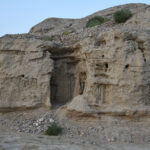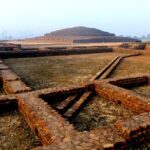The Gangetic Plains See Urban Settlements
800–600 BCE
Agricultural clans and tribes led by rajans (military chiefs) spread across the Gangetic Plains. They lay the basis for proto-kingdoms and civil governance through the development of concepts of tribal land, inheritance, enslavement, complex ideas of metaphysics, and new rituals and sacrifices. Although little to no art historical evidence will survive from these early kingdoms, literary evidence will suggest the consolidation of political power in Hastinapur, Kaushambi and Shravasti in present-day Uttar Pradesh, and Champa in present-day Chhattisgarh in India. These polities had trade routes, markets and agricultural centres.
Bibliography
Erdosy, G. “The Origin of Cities in the Ganges Valley.” Journal of the Economic and Social History of the Orient 28, no. 1 (1985): 81–109. https://doi.org/10.2307/3631864.
Lahiri, Bela. Indigenous States of Northern India (Circa 200 B.C. to 320 A.D.). Kolkata: University of Calcutta, 1972.
Lal, B. B. “The Painted Grey Ware Culture of the Iron Age.” In History of Civilisations in Central Asia Volume 1, edited by. A. H. Dani and V. M. Masson, 412–31. Paris: UNESCO Publishing, 1992.
Singh, Upinder. A History of Ancient and Early Medieval India: From the Stone Age to the 12th Century. New Delhi: Pearson, 2016.
Erdosy, G. “The Origin of Cities in the Ganges Valley.” Journal of the Economic and Social History of the Orient , vol.28, no.1 (1985), 81–109. https://doi.org/10.2307/3631864.
Lahiri, Bela. Indigenous States of Northern India (Circa 200 B.C. to 320 A.D.) , Kolkata:University of Calcutta, 1972.
Lal, BB. “The Painted Grey Ware Culture of the Iron Age.” In History of Civilisations in Central Asia , Volume 1, ed. A.H. Dani and V.M. Masson (Paris: UNESCO Publishing, 1992), 412–431.
Singh, Upinder. A History of Ancient and Early Medieval India: From the Stone Age to the 12th Century . New Delhi: Pearson, 2016.
Feedback 
This entry appears in
Art in South Asia
Visit Timeline
Associated Timeline Events
First Published: March 11, 2024
Last Updated: May 28, 2024








